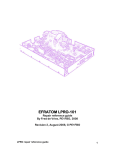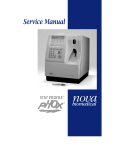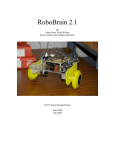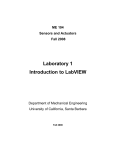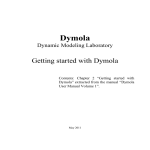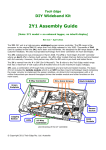Download Laboratory 6a Closed Loop Analog Control Of DC Motor Velocity
Transcript
ME 104 Sensors and Actuators Laboratory 6a Closed Loop Analog Control Of DC Motor Velocity Department of Mechanical Engineering University of California, Santa Barbara (Rev. 2007) Introduction In this laboratory, you will build analog circuits on a breadboard to implement proportional (P) and integral (I) control of a DC motor. NOTE: • For this lab, you will need yourname_MotorDrive_AcquireVoltage.vi which you created for Lab 4. • You will write ONE REPORT FOR EACH Labs 6a and 6b. Background Reading Please read the following material prior to this lab: 1. Histand and Alciatore, Introduction to Mechatronics, Sections 5.1-5.8 and Sections 5.10-5.11. 2. DC Motor Control Module User Manual, Pages 3-7 and 14-16, LJ Technical Systems Inc. Experiment 1a: Open Loop Control of DC Motor Velocity In this experiment, you will use a LabVIEW VI to drive a DC motor, similar to what you did in Laboratory #4. You will observe both the motor drive input VIN and the tachogenerator output VOUT (velocity feedback) on an oscilloscope. VIN Drive Circuits D/A DC Motor Converter VOUT DAQ board PC Velocity Shaft Sensor Rotation DC Motor Module Ch. 1 Ch. 2 Oscilloscope Figure 1. Open loop control of DC motor velocity 2 In control system terminology, the system shown in Figure 1 is described as an open loop control system. This is because the control (drive) signal VIN to your plant (the DC motor module) does not directly (automatically) depend on the output signal VOUT. Figure 2 shows the open loop control system in block diagram form in which the following notation has been used: P(s) = Plant (DC Motor module) * u = control input to VIN socket on Motor Drive Input panel I = Identity block (D/A Converter) rVI = reference signal from LabVIEW VI Tachogenerator Output panel r = reference signal rV I y = plant output from VOUT socket on r u Plant y P(s) I Figure 2. Open loop control block diagram The D/A converter is represented by an identity block to indicate that the reference value seen by your system should be equal to the reference value specified by your LabVIEW VI. For this experiment, you will drive the DC motor such that the reference value is equal to the control input. That is, r = u. 1. Set the appropriate switches on your DC motor control module so that you can drive the motor with analog voltage input and also obtain analog velocity feedback from the tachogenerator output. • MOTOR DRIVE switch: VIN position – selects analog motor drive input • TACHOGENERATOR switch: VOUT position – enables analog velocity feedback output 2. Use a banana connector to connect the E (Enable Input) socket to the 0V socket to enable the input to drive the motor. 3. Connect the 0V sockets (Analog ground) on MOTOR DRIVE INPUT panel and TACHOGENERATOR OUTPUT panel to common ground. * The P(s) notation indicates that the Plant is represented mathematically by its transfer function. 3 4. To drive the motor using the analog voltage output from the DAQ board, connect your motor control module to the CB-68LP connector block according to Table 1. Table 1. CB-68LP connector block pin assignments for open loop control of DC motor velocity. DC Motor Control Module VIN socket (Analog voltage) on MOTOR DRIVE INPUT panel Connect to: VOUT socket (Analog voltage) on TACHOGENERATOR OUTPUT panel AO0 AI0 Ground on DC power supply* AIGND Ground on DC power supply* AOGND *The connector block can also be grounded to the breadboard if the breadboard is grounded to the DC power supply. 5. Before connecting the DC power supply to the motor module, turn ON the DC power supply and make sure the variable output terminals are properly configured to provide –12 V and +12 V. 6. Turn OFF the DC power supply, then connect the power supply to the DC motor module. 7. Make sure that no wires or cables interfere with the moving parts of your motor. 8. Turn ON the DC Power Supply. 9. Make sure the Eddy Current Brake is disengaged. That is, make sure it is in the 0 position. 10. Connect your DC motor control module to your oscilloscope such that the reference r ( = VIN ) is viewed on Channel 1 and the velocity feedback VOUT ( = y) is viewed on Channel 2. For best viewing, set your vertical scales to 1volt/division and your horizontal scale to 400 ms/division. 11. Open and run yourname_MotorDrive_AcquireVoltage.vi (created for Lab 4) by clicking the Run Continuously button. Incrementing by units of 1.00 V from -4.00 V to +4.00 V (inclusive) for the Motor Drive Input Control, observe the voltage signals on Channels 1 and 2 of your oscilloscope. * For each increment, make a sketch of the transient behavior and write down the steady state † values of r and VOUT (as displayed by the digital indicators on your VI front panel). 12. Set the Eddy Current Brake to the 1 position and repeat Step 7. This brake acts as an external disturbance to your system. 13. Set your Motor Drive Input Control to 0.00 and stop running the VI by clicking the Abort Execution (stop) button. * To avoid saturation effects, the boundary reference values of [–5.00 V to 5.00 V] is reset to [-4.00 V to 4.00V]. † “Steady state” means that you have waited long enough that transient motion has ceased. 4 Although one would like (and expect) VIN ( = y) and VOUT ( = r ) to be equal, you should have observed that they are not equal, except when VIN = 0V. That is, your plant P(s) has a steady-state error for nonzero reference values. In other words, in the absence of output information, the magnitude of your plant (motor) velocity is slightly different from what you would like it to be. This situation can be improved using closed loop (feedback) control. Experiment 2a: Proportional (P) Control of DC Motor Velocity In this experiment, you will use a LabVIEW VI and a proportional (P) feedback control circuit to control a DC motor. Figure 3 shows the closed loop control system in block diagram form in which the following notation has been used: P(s) = Plant (DC Motor module) e = error signal = r - y K(s) = Controller u = control input to VIN socket on Motor Drive Input panel I = Identity block (D/A Converter) y = plant output from VOUT socket on rVI = reference signal from LabVIEW (VI) Tachogenerator Output panel r = reference signal rVI r I D/A Converter e + Σ Controller K(s) u Plant y P(s) - Figure 3. Closed loop (feedback) control block diagram Mathematically, the proportional controller can be described in the time domain as u P (t ) = K P e(t ) where uP is the output and KP is a constant gain. Figure 4 shows the system diagram for the closed loop control system of the DC motor. 5 r u D/A Drive Circuits Control Circuit Converter Velocity DAQ board y rVI PC Sensor DC Motor Shaft Rotation DC Motor Module Ch. 1 Ch. 2 Oscilloscope Figure 4. Closed-loop control of DC motor velocity Note that you need to provide power to both the DC motor module and the analog circuits on the breadboard. The DC motor module requires voltage supplies of +12 V, -12 V, +5 V, and ground. The analog circuits include LMC6484 op-amps which require voltage supplies of V+ = 5 V and V- = 5 V. Since the DC power supply at each station has only three output terminals and four different voltage outputs (+12 V, -12 V, +5 V, and –5 V) are needed, an L7905ACV negative voltage regulator is used to convert the -12V signal from the power supply to –5 V for the op-amp. 2 VIN = -12 V 0.1 μF L7905ACV 3 IN VOUT = - 5 V OUT GND 1 (a) 0.1 μF L7905ACV WK0040342 CHINA Build the voltage regulator circuit, shown in Figure 5. Follow the wire color scheme in Table 2. 3 – OUTPUT 2 – INPUT 1 – GROUND (b) Figure 5. (a) Voltage regulator circuit. (b) Pin assignment for L7905ACV negative voltage regulator. 6 Table 2. Wire color scheme Wire color Red Purple White Green Black Voltage +12 V -12 V +5 V -5 V 0 V (Ground) 1. Using a voltmeter, verify that the output voltage of the voltage regulator circuit is –5 V. 2. Build the proportional control (p-control) circuit, shown in Figure 6 . Two LMC6484 op-amps have been pre-inserted on your breadboard. Build the p-circuit on the LEFT op-amp on the breadboard. Pin assignments for the op-amp are shown in Figure 7. Remember to provide positive power (V+ = 5V from “5V FIXED 3A” terminal on power supply) to Pin 4 and negative power (V- = -5V from voltage regulator circuit) to Pin 11 * . Choose your resistors such that R = 100 kΩ and RF = 4.7 MΩ. Then, KP = 1+ RF = 48 . R 2 1 Figure 6. Proportional control circuit. The circuit consists of a difference amplifier (that calculates the error) followed by a noninverting amplifier that multiplies the error by a constant gain KP. (Note: Power supply connections are not shown for clarity.) * As a safety precaution, use your voltmeter to verify the values of your positive and negative supply voltages. 7 Figure 7. LMC6484 op-amp connection diagram 3. Connect the reference signal r from AO0 (Analog Output 0) to the proportional control circuit as shown in Figure 6. 4. To drive the motor using the proportional control signal uP from the proportional control circuit, connect your motor control module and proportional control circuit to the CB-68LP connector block according to Table 3. Table 3. CB-68LP connector block pin assignments for proportional control of DC motor velocity. DC Motor Control Module Connect to: VIN socket (Analog voltage) on MOTOR DRIVE INPUT panel P feedback circuit output (uP connection). VOUT socket (Analog voltage) on TACHOGENERATOR OUTPUT panel AI0 and P feedback circuit input (y connection). 5. Retain the ground connections from Experiment #1a. 6. Retain your oscilloscope connections from Experiment #1a. That is, connect your DC motor control module to your oscilloscope such that the reference r (AO0) is viewed on Channel 1 and the velocity feedback y = VOUT (AI0) is viewed on Channel 2. 7. Make sure the Eddy Current Brake is disengaged. That is, make sure it is in the 0 position. 8 8. Run yourname_MotorDrive_AcquireVoltage.vi (from Lab 4) by clicking the Run Continuously button. Increment the Motor Drive Input Control by 1V from –4.00 V to 4.00 V, inclusive, and observe the voltage signals on Channels 1 and 2 of your oscilloscope. Make a sketch of the transient behavior and write down the steady state values of r and y (as displayed by the digital indicators on your VI front panel). 9. Set the Eddy Current Brake to the 1 position and repeat Step 5. 10. Set your Motor Drive Input Control to 0.00 and stop running the VI by clicking the Abort Execution (stop) button. Although the velocity signal y ( = VOUT ) is closer to the reference value r than in the open loop case (Experiment #1), the two signals are still unequal. In other words, tracking has improved, but your plant P(s) still shows a steady-state error for nonzero reference values. This steady-state error can be eliminated using closed loop integral control. Experiment 3a: Integral (I) Control of DC Motor Velocity In this experiment, you will use a LabVIEW VI and an integral feedback control circuit to control a DC motor as shown in Figures 3 and 4. Mathematically, the integral (I) controller can be described in the time domain as t u I (t ) = K I ∫ e(η )dη 0 where uI is the output and KI is a constant gain. 1. Use the two remaining op-amps on the left LMC6484 chip to build the integral control circuit shown in Figure 8. Provide the error input (e) to this circuit from the (first half of the) circuit you built in Experiment #2a. Choose your resistors and capacitor such that R = 100 kΩ, RF = RI = 1 MΩ, and C = 0.1 μF. Then, ⎛ 1 ⎞⎛ RF ⎞ ⎟⎟⎜ − K I = ⎜⎜ − ⎟ = 100 . ⎝ RI C ⎠⎝ R ⎠ 9 I 3 4 Figure 8. Integral control circuit. This circuit consists of an integrator (that calculates the error integral) followed by an inverting amplifier that multiplies the error integral by a constant gain KI. . (Note: Power supply connections are not shown for clarity.) 2. To drive the motor using the integral control signal uI from the feedback control circuit, connect your motor control module and feedback circuit to the CB-68LP connector block as shown in Table 4. Table 4. CB-68LP connector block pin assignments for integral control of DC motor velocity. DC Motor Control Module Connect to: VIN socket (Analog voltage) on MOTOR DRIVE INPUT panel I feedback circuit output (uI connection). VOUT socket (Analog voltage) on TACHOGENERATOR OUTPUT panel AI0 and feedback circuit input (y connection). 3. Retain the ground connections. 4. Retain your oscilloscope connections from Experiment 1a. That is, connect your DC motor control module to your oscilloscope such that the reference r (AO0) is viewed on Channel 1 and the velocity feedback y = VOUT (AI0) is viewed on Channel 2. 5. Make sure the Eddy Current Brake is disengaged. That is, make sure it is in the 0 position. 6. Open and run yourname_MotorDrive_AcquireVoltage.vi by clicking the Run Continuously button. Increment your Motor Drive Input Control by 1V from -4.00 V to +4.00 V, inclusive, and observe the voltage signals on Channels 1 and 2 of your oscilloscope. Make a sketch of the transient behavior and write down the steady state values of r and VOUT as displayed by the digital indicators on your VI front panel. 10 7. Set the Eddy Current Brake to the 1 position and repeat Step 5. 8. Set your Motor Drive Input Control to 0.00 and stop running the VI by clicking the Abort Execution (stop) button. Your plant P(s) should show zero steady-state error for all reference values. However, this has been achieved at a price. Namely, your system experiences transient oscillations that you did not observe previously. In other words, although the velocity signal y = VOUT will equal the reference value r after a sufficient amount of time has passed, the velocity has a tendency to overshoot its intended target at the onset. By combining proportional and integral control, the (desired) zero steady-state error condition can be maintained, but with significantly reduced overshoot. You will investigate in next week’s lab. Retain your P and I control circuits for next week’s lab. Laboratory Report 1. For the VI’s you used in this laboratory, provide a printout that shows the front panel and block diagram. 2. Using the data you collected with the Eddy Current Brake in the 0 position, provide a graph of steady-state velocity (voltage) output y versus reference (voltage) signal r * for the following control methods: (a) open loop, (b) proportional, and (c) integral. For comparison, all three control methods should be plotted on the same graph. Clearly indicate which plot corresponds to which control method and compare the steady-state performance of the different control methods. 3. Repeat Question 2 for the data you collected with the Eddy Current Brake in the 1 position. Is there a notable difference between your plots in Question 2 and Question 3? Explain. 4. Using the observations you made with the Eddy Current Brake in the 0 position, provide a sketch of your DC motor’s transient behavior. All three control methods should be shown on the same sketch (graph) for comparison. Compare the transient behavior of each of your control methods. 5. Repeat Question 4 for the observations you made with the Eddy Current Brake in the 1 position. * Your x-axis should consist of the values r = [ -4, -3, -2, -1, 0, 1, 2, 3, 4 ], with units in volts. 11 Your Lab Report should clearly state your name, Lab Report number, Lab date, and your laboratory partner’s name (if any). Your lab report should be thorough, but concise. You will be graded on quality, not quantity. Lab Report #6a is due at the beginning of Laboratory #6b. 12














